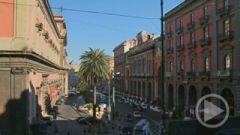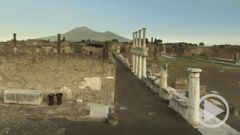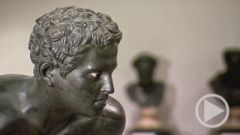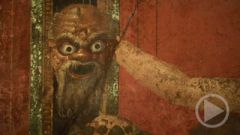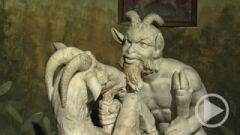The Mosaics
The Mosaics
The explosion of colors and images in the Roman houses was not limited to the walls. The tremendous popularity of mosaics spread from Greece to Italy in the first century BC. Initially mosaics were simple, geometric patterns that adorned the floors of the houses like carpets. But soon artists began to insert pictorial panels into the center of the patterns, so-called “emblemata”. One of the earliest examples in Pompeii comes from the Villa of Cicero. The picture shows actors with comedy masks and musical instruments, and is signed by a Greek master named Dioskurides. The following decades saw the creation of more and more pictorial mosaics of amazing virtuosity.

The House of the Tragic Poet got its name from a mosaic that also shows a scene from the theater. It was once the centerpiece of the tablinum, the house’s elegant reception room. In the picture a troupe of actors is preparing to perform a satyr play, a burlesque that was put on for comic relief between tragedies. On the left, two actors are already dressed as satyrs – lustful demons, half man-half goat. The flutist is warming up while the director or author gives final instructions. The actor on the far right has probably arrived late – he is (hurriedly) slipping into his costume. In front of him is a typical theater mask. Such masks appear over and over again as decorations in Pompeii and Herculaneum. The Romans enjoyed the game of illusion and reality.

But not all pictures were as light-hearted. This famous mosaic was found – incongruously – in the summer dining room of a Pompeian home. “Memento mori – remember you must die!” When the owners and their guests dined on warm evenings, this picture was a constant reminder of the transience of their pleasures.
The skull is suspended above a butterfly, the symbol of the soul. Beneath it is a wheel, standing for “fortuna”, chance, that can turn at any moment. The skull is also the plummet on the plumb-line of a libella - a precursor of today’s spirit level. The left arm of the tool lifts a scepter and a costly purple cloak. The counter-weight is a beggar’s staff and ragged sack. But the arms are balanced; in the face of death – the great leveler – there is no difference between rich and poor.
A battle is in full swing. On the field where the riders are clashing, a single bare tree reaches its branches to the sky. Weapons lie scattered and broken on the ground. Lances point into the air; horses rear and fall. A chariot drawn by four horses is making its way through the midst of the turmoil. The commander stands high above his warriors. In his left hand he holds the bow whose arrows he has shot. The white stripe woven into his tunic identifies him as the great king of the Persians – Darius, one of the mightiest men of the world. His expression reflects horror – for he has just spied his opponent in the crush of battle.
From the left HE is sweeping forward, in light-colored armor adorned with a Medusa’s head. His black hair waves like a lion’s mane around the keen, youthful face. His large eyes are firmly fixed on his mortal enemy. This is Alexander the Great.

His stallion Bucephalus with his broad head rears up over a wounded horse. Alexander’s lance has impaled its rider, who, in agony grasps the deadly weapon to deflect it. But his body has received the stab and in death he has rescued the object of the attack. Panicking, Darius’s charioteer has turned the horses around, but it is too late. Alexander is already too close.
This mosaic, possibly the most famous one of all time, is believed to depict the Battle of Issus between Alexander the Great and Darius III in the year 333 BC. The work may be based on a lost painting thought to have been executed shortly after the battle.
One of the elements demonstrating the great artistic mastery of this work is the horse in the middle. Almost uncontrollable, it is shown from behind in a radical perspective which heightens the impression of chaos in the raging battle.
The Alexander Mosaic measures 19 by 10 feet and is made up of around one and a half million stones. It was discovered in 1831 in the largest of the private villas in Pompeii, the House of the Faun. Since 2005 a copy has been in the tablinum of the house. It took nine mosaic artists working nearly two years to make it.
When Pompeii was destroyed, the Alexander Mosaic was nearly two hundred years old and had already suffered some damage. The large conspicuous gaps in the left half of the picture are thought to have been caused by the great earthquake of 62 AD.


